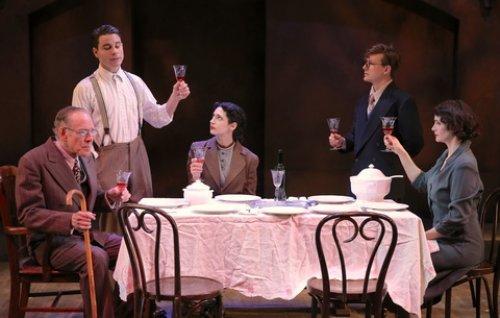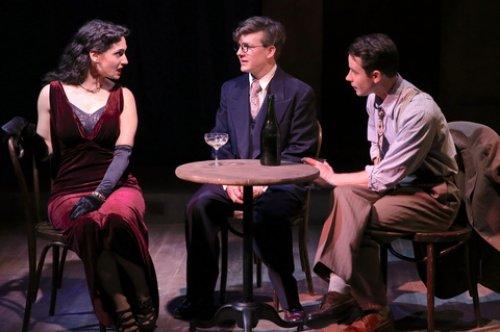Vilna
This play should be seen by those who have never been taught the tragic story of the Holocaust.

Seamus Mulcahy and Mark Jacoby in a scene from Ira Fuchs’ “Vilna” (Photo credit: Carol Rosegg)
[avatar user=”Joel Benjamin” size=”96″ align=”left” ] Joel Benjamin, Critic[/avatar]
Vilna, written by Ira Fuchs, is one of the more successful stage dramas to deal with the Holocaust, a notoriously difficult subject to portray on stage. That this play succeeds as well as it does is to the credit of its director Joseph Discher who assiduously avoids clichés and stereotypes and its cast of fine actors, led by the great Mark Jacoby, a star of Broadway musicals, here displaying heart-breaking depth of emotion in two parts.
Vilna refers to the city that had been a bustling center of Jewish culture until after World War I. The city was subject to a tug of war between Poland and Lithuania, finally becoming the capital of Lithuania as Vilnius.
During the historical period of Fuchs’ play, Vilna was part of Poland and the thriving Jewish culture was under continual attack, disappearing totally after the Nazis and their Lithuanian henchmen assassinated the entire Jewish population after herding them into two ghettos.
Two characters are at the emotional center of Vilna: Motke Zeidel (Sean Hudock, beautifully morphing from naïve student to valiant hero) and Yudi Farber (Seamus Mulcahy, a boyish-looking actor whose looks belie his emotional range), boyhood friends so close that Motke’s family virtually adopts the orphaned Yudi.

Carey Van Driest, Seamus Mulcahy, Sophia Blum and Sean Hudick in a scene from Ira Fuchs’ “Vilna” (Photo credit: Carol Rosegg)
Vilna opens with the Ghost of Motke (Jacoby) hovering over Brittany Vasta’s flexible, multi-portaled set, an affecting image that says this is a story “You need to know.”
Vilna proceeds chronologically from the 1920’s when Motke and Yudi meet at school to the 1940’s when World War II engulfs them and their family, friends and fellow Jews in a wave of hatred and violence.
Motke’s family includes the much-principled father Josef (Jacoby), proprietor of a once thriving glove company ruined by war-time shortages and official graft, and his physician wife, Naiomi (Carey Van Driest, solid throughout) who works at the sole hospital in Vilna that treats Jews, an institution doomed to a brutal end.
Vilna is brimming with colorful characters, some sympathetic, some not and some changing as circumstances change, most based on real people.

Mark Jacoby Sean Hudick, Sophia Blum, Seamus Mulcahy and Carey Van Driest in a scene from Ira Fuchs’ “Vilna” (Photo credit: Carol Rosegg)
Bruno Kittel, icily handsome Nazi officer in charge of removing the Jews, is played with easy sadism by Paul Cooper. He is in charge of several underlings whom he chastises for their inefficiency in murdering Jews.
Pietr, a friend of Motke, played with increasing sympathy by Tom Morin, begins as a simple worker delivering coal and winds up showing some spine. Sophia Blum takes on two characters: a Zionist organizer doctor striving to keep the hospital running and a sexy cabaret singer who uses her feminine wiles to stay alive, shining in both roles. Brian Cade essays two unsympathetic roles and gives them whatever humanity he can muster, as does Patrick Toon. Two more sympathetic characters are portrayed by Nathan Kaufman, a rabbi and the troubled head of the Judenrat, the Nazi-appointed head of Jewish ghettos.
At nadir of the Jews’ tragic story Vilna becomes an escape drama involving the two main characters who valiantly defy their killers leading to a heartrending ending.
In Vilna, the Nazi plans for the annihilation of the Jews are so matter-of-fact, so seemingly rational that they are all the more horrific. The Nazi Bruno details to his underlings just how many bodies should lie in a row in the killing pit in the forest outside the city before they are shot and covered by another layer of victims. It’s as if he is talking about laying charcoal briquettes on a barbecue grill. Absolutely chilling.

Sophia Blum, Seamus Mulcahy and Sean Hudick in a scene from Ira Fuchs’ “Vilna” (Photo credit: Carol Rosegg)
Of course Vilna cannot avoid the obvious problems endemic to dramas of its ilk. The actors cannot possibly look like Holocaust victims. Even Devon Painter’s astutely designed period costumes look too neat and clean, with the exception, of course, the pressed and tailored uniforms of the Nazis and their Lithuanian colleagues.
Nevertheless Vilna should be seen by those who were brought up with the specter of the Holocaust hovering over them—as I was—and by those who are no longer informed about this blot on history.
Fortunately, the audience at the performance under review was filled with young people, many of whom gasped at the inhumanity they were witnessing.
Harry Feiner’s lighting design made the most of the set, but also changed subtly as the subject matter became drearier and drearier. Likewise, Jane Shaw’s sound design not only provided ambiance but also helped exaggerate the despair of the final scenes of the play.
Vilna (through April 14, 2019)
Theatre at St. Clement’s, 427 West 46th Street, in Manhattan
For tickets, call 212-239-6200 or visit http://www.vilna-the-play.org
Running time: two hours and 30 minutes including one intermission






The acting was brilliant, the emotion was raw and from a technical perspective the set, lighting, and sound moved the audience through the story beautifully. The two and one-half hours flew by. I had a visceral reaction to this powerful story!